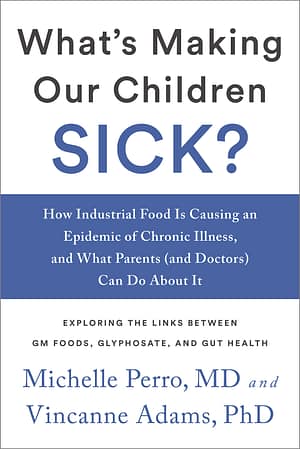The Pervasive Presence of Unregulated Chemicals in America

How are chemicals regulated for use on our food? How do they affect our bodies? These are just two of the crucial questions proposed by Michelle Perro and Vincanne Adams. Unfortunately, it seems the US government does not consider these questions as critically as they should. Read on to learn more about the genetically modified crops that are saturating our food supply.
The following excerpt is from What’s Making Our Children Sick? by Michelle Perro and Vincanne Adams. It has been adapted for the web.
The concerns raised by environmental health scholars are similar to those raised by researchers looking at pesticides. Most people would be surprised, however, to learn there is a shocking lack of rigorous testing and regulation of chemicals in the United States. One would expect our food supply to be well regulated, but in far too many cases the three federal government agencies that bear responsibility for some aspect of food safety have not been exercising adequate oversight. These agencies are the FDA, the USDA and the EPA.
The FDA has been granted the major role, and it is supposed to be exercising great precaution. According to the stipulations of the Food, Drug, and Cosmetic Act, this agency must ensure that all new additives to our food that do not have a safe history of use prior to 1958 are demonstrated to be safe via standard scientific testing before they’re allowed on the market. In cases where sufficient technical evidence of safety has already been produced, and this evidence is well-recognized among experts, the new additive can be deemed to be “generally recognized as safe” (GRAS), and the manufacturer is not required to produce additional evidence. But these precautionary safeguards have been violated when it comes to genetically engineered foods. As the public interest attorney Steven Druker has revealed in his book, Altered Genes, Twisted Truth, even though the FDA has acknowledged that the various pieces of DNA inserted into genetically engineered organisms are within the purview of these laws, it has claimed they are exempt from testing because they are GRAS—despite the fact its own files demonstrate the agency knew that neither of the requirements for GRAS status had been satisfied. Druker argues that although (1) the FDA’s own experts concluded that GM foods pose abnormal risks and need to be tested, (2) the agency also knew that a significant number of experts outside the agency also believed that safety testing is needed, and (3) the agency additionally knew that no technical evidence of safety had been generated, it covered up these facts and falsely proclaimed that the conditions for GRAS had been satisfied. Accordingly, Druker states that the FDA allowed GM foods to come to market without requiring any testing whatsoever. GM foods that are pesticides or PIP (plant-incorporated protectant) are regulated by the EPA.

Finally, the EPA was established in 1970 with a more general and loosely defined responsibility to protect human health and the environment, based on monitoring, standard setting, and enforcement. In 1976, Congress passed the Toxic Substances Control Act, which gave the EPA full power to control chemicals that posed a health risk to humans and the environment. But have they?
The EPA’s task has been to monitor the nearly 100,000 chemicals produced in or imported into the United States. Of these 100,000 chemicals, the EPA has only taken action to reduce the risk of over 3,600 chemicals, and it has banned or limited the production or use of only 5. It has not actually regulated a single chemical in the United States since the mid-1980s. Keep in mind, the EPA is the same agency responsible for determining the safe limits of pesticide residues in plants that are produced for human consumption.
On top of all this, the EPA’s central stance on regulation is that chemicals are safe until proven otherwise. However, just how it determines this “safe” level is surprising. To determine maximum levels of exposure for certain chemicals, the EPA samples the concentrations of a chemical in the population. In other words, the EPA does not conduct rigorous research on the effects of chemicals; rather, it surveys the population and figures out how much is already present with the assumption that that amount is safe. This sets a range for an acceptable amount.
The EPA also does rigorous searches of the available research literature on toxicity from chemicals. The obvious flaws in this logic are twofold: First, adverse health effects are often not immediate or acute, but rather are long term before they develop as chronic problems. It is difficult to decipher exact causes of environmentally induced health effects, especially if they take a long 
Second, in regard to the EPA’s use of scientific studies when it comes to foods, it follows the pattern of the FDA. Many studies on chemicals in foods are focused on establishing equivalence with existing foods, showing that they are no more dangerous than foods already in circulation. Thus, most foods do not fall under the scrutiny of the EPA, just as they don’t under the FDA. The EPA does, however, exercise regulatory power over the use of foods that have become pesticides in and of themselves (such as some GM foods) because it is charged with regulating pesticides. However, the EPA has never actually curtailed use of these pesticide foods.
Finally, studies on chemical toxicities that are done in animals are almost exclusively done by the industries that produce and sell them, raising questions about bias and validity that are seldom heard at any of these regulatory agencies. The EPA accepts standards set by chemical companies that are based on their own research of “safe levels” or what are called “no observed adverse effect levels” (NOAELs). These levels are based on exposure tests on animals or humans, comparing biologically or statistically significant changes between test and control groups for alteration of morphology, functional capacity, growth, development, or life span. The EPA takes into account a variety of different measures of safe levels, which can vary from state to state, including no significant risk levels (NSRLs), maximum allowable dose levels (MADLs), and chronic reference dose levels (cRfD), depending on what type of disorder or toxicity one is looking at.
What all this adds up to is that despite the fact that many of these chemicals have been assigned “safe levels” of exposure and are on the market for use in our homes, schools, and businesses, they are often adjusted later, after reports begin to trickle in about possible effects or about exposure-related effects that are below these safe levels. Even when safety levels are set, often these minimal regulations are only made by the EPA in response to complaints, lawsuits, and hard-fought advocacy work of public interest organizations, rather than because the EPA is proactive and, on its own, does research to test safety.
Shifting the burden of proof of safety to industries has resulted in outcomes that should have been expected; industries are not very good at policing themselves. And, it turns out, neither is the EPA, FDA, or USDA very good at protecting us. The coordination between industry, health researchers, and government regulation in the area of agrochemicals used in food production is abysmal. So, if we are quite literally surrounded by and bathing in—and entirely unable to escape from—the chemical hurricane that has arrived with the scientific engineering of our food supply, what sort of science, what kind of regulation, and what sort of medicine should we practice to deal with this?
To answer this question, we first need to explore what these poisons are and how exactly they impact our health. It turns out that answering these questions is not so easy. After all, not everyone who eats these foods gets sick, or at least not right away. In fact, some people never do, and this has created huge skepticism among many. Food industries and agribusinesses have spent a good deal of time assuring us that these foods and the chemicals we use to grow these foods are safe. Finally, again, the USDA the EPA, and the FDA are not telling us that these crops are dangerous. Is it possible, however, that in our effort to ensure a sufficient food supply and profit margin for our farming communities we have had the wool pulled over our collective eyes when it comes to food safety?
Leaving aside the issues of meat, poultry, and dairy that are full of antibiotics and hormones (and that eat grain and grass crops that are genetically modified), what are these crops we are so worried about? The genetic engineering technologies that are of particular concern to food-focused medicine are twofold. First is the genetic engineering of crops so that they are resistant to the herbicide Roundup, referred to as “Roundup Ready crops.” These crops are specifically modified genetically to withstand death from glyphosate. That is, they are designed to enable use of Roundup. The second is the genetic engineering of crops so they contain the natural insecticide Bacillusthuringiensis toxin (Bt toxin). Bt is almost always used in conjunction with Roundup Ready genetic modifications. Plants modified with Bt are designed to kill pests trying to eat them; in fact, the plants themselves are turned into insecticides. No matter what part of the plant is eaten by a pest, it will kill the insect. Again, arguments for and against the safety of these genetic engineering technologies in food crops are controversial on both sides.
When you consider that most of the Roundup Ready crops, including soy, corn, canola, alfalfa, cotton, sugar beets, apples, potatoes, and, soon, wheat (although experimental forms of genetically modified wheat do exist), are getting drenched in glyphosate and other herbicides as a normal part of their agricultural production, questions about how many of these chemicals are ending up in the foods we eat, and in the environment, naturally follow.

When you further consider that many of these food crops are themselves also modified to act like pesticides against living organisms, questions about what exactly these foods are doing inside of our guts, and specifically to the microorganisms in our guts, naturally arise as well. When you consider that poultry and livestock are fed foods with these same genetic modifications, plus the large quantities of added herbicides that accompany them, then questions about the pervasive dissemination of these chemicals into the animals that we consume escalate quickly. Finally, when you consider that most processed foods—even baby formula and baby foods in most US grocery stores today—are made from these crops (especially soy and corn or their derivatives), then one begins to see the contours of our contemporary Silent Spring.
Exactly how are these chemically dependent tactics for food production impacting the human body and specifically the health of our children? There is much less information about this topic, and virtually none available to clinicians. Even clinicians who are aware of these profound disruptions in the environment and in our food will have a hard time parsing the information and applying it to their clinical practices. This interface is challenging at best, daunting at worst. This lack of information is appalling considering the pervasiveness of genetically modified crops that saturate the food supply of Americans today.
Recent Articles
Want to start your own medicinal herb garden? Passionflower, lemon balm, and goldenseal are great places to begin! These herbs are jam-packed with medicinal properties and easy to grow in a majority of climates.
Read MoreSprouts are easy to cultivate, mature quickly and pack a nutritional punch! You can make nutrient-rich sprouts from all kinds of edible seeds in your kitchen.
Read MoreSuffering from frequent headaches is miserable and immobilizing. If you haven’t had luck treating and preventing your headaches, skip the over-the-counter approach and prepare herbal formuals for migraines to use in the future! The following is an excerpt from Herbal Formularies for Health Professionals, Volume 4 by Jill Stansbury. It has been adapted for the…
Read More“It is more important to know what kind of person has a disease than to know what kind of disease a person has.” —Hippocrates Drawing on her decades of clinical experience and her extensive research, Dr. Jill Stansbury offers an unparalleled range of herbal formulas in her five-volume set, Herbal Formularies for Health Professionals. For each…
Read More








